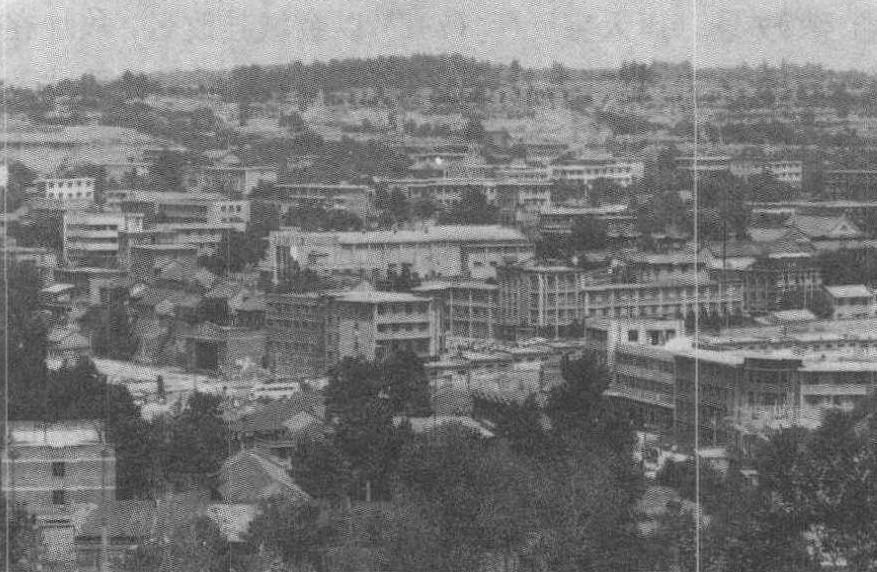扶风县
宝鸡市辖县。位于宝鸡市东部,县城距宝鸡市区98公里。东邻永寿县、乾县、武功县、杨陵区,南接周至县、眉县,西连岐山县,北靠麟游县。南北长45.6公里,东西极端宽度27.6公里,总面积745.8平方公里,其中耕地面积72.8万亩。人口42.2万,其中农业人口39.7万。汉族人口占99.96%,回、满、蒙古、维吾尔、朝鲜、纳西等11个少数民族人口不足200人。县辖城关、绛帐、法门寺、召公、杏林5个镇和揉谷、上宋、午井、新店、太白、建和、天度、段家、南阳、黄堆10个乡。县人民政府驻城关镇。
扶风得名始于西汉,初为官职名,取“扶助京师,以行风化”之意。东汉为郡名,唐初始为县名。周以前相继属姜氏国、岐伯国、郮国、岐邑之地。秦汉间分属邰县、美阳县,北周属三龙县,隋属岐山县。唐武德三年(620)建𣲗川县,唐贞观八年(632)定名扶风县。宋建炎元年(1127)更名扶兴县,后复原名,归凤翔府领辖。元、明、清代无变更。民国初属关中道,1935~1949年归陕西省第九督察专员公署管辖。1949年7月13日解放,1958年12月并入兴平县,1961年8月恢复扶风县建制。
县北部为野河山区,中部为平坦的黄土台原,南部为渭河川道。最高点北部山区的瓦罐岭主峰海拔1579.8米,最低的揉谷乡石家小村438米。年平均气温12.4℃,年降水量591.8毫米,年日照2134小时,无霜期200~220天。渭河横贯东西,境内流程18.7公里。境内有小𣲗河、漆水河、美阳河、七星河、太川河、野河、清水河。宝鸡峡引渭工程、冯家山水库、渭惠渠等水利工程年均供应全县水量1亿多立方米。
扶风历史悠久,历史名人有马援、马融、马超、马钧、班彪、班固、班超、窦滔、窦融、耿弇等。境内文物以古、博、稀、奇见称,有周原遗址、法门寺、封神台遗址以及城隍庙、𣲗峰塔等名胜古迹。其中,周原遗址系国家级文物保护单位,是周王朝古都所在地。这里出土珍贵文物数千件,毛公鼎被清王朝誉为清宫大瑰宝;被尊为“关中塔庙之祖”的法门寺,是我国境内安置释迦牟尼真身舍利的著名寺院,现存4枚佛指舍利为当今世界所绝无仅有。法门寺地宫珍宝(现藏法门寺博物馆)包括秘瓷、武则天的绣裙、石雕、金银器等600余件,是我国迄今发现的唐代等级最高,历史背景清楚,纪年明确,历史、科学和艺术价值极高的珍贵文物。法门寺于1988年对外开放,已成为闻名中外的游览胜地。
扶风是后稷教民稼穑的传统农业区,是陕西省商品粮、油、苹果、辣椒、生猪、奶山羊、秦川牛等农产品生产基地县之一,农业生产具有较高水平。1990年,全县拥有农业机械总动力15.69万千瓦,大中小拖拉机8150台,机耕、机播面积分别占农作物总播种面积的66.4%和52.6%。有14座水库,114个陂塘,338座抽水站,2236眼机井,有效灌溉面积61.7万亩,占耕地的85.7%。粮食作物有小麦、玉米等11种。经济作物有油菜、辣椒、瓜类、蔬菜等22种。饲料和绿肥作物有苜蓿、毛苕子、草木樨、沙打旺4种。果树有苹果、梨、桃、杏、柿子、核桃、红枣等10余种。森林覆盖率15.2%。人工饲养的畜禽有黄牛、马、骡、驴、猪、羊、鸡等15类50多个品种。有野生动物数十种,野生药材15种。1990年,粮食播种面积93.55万亩,总产24.9万吨,居宝鸡市各县之首。油料播种面积7.07万亩,总产7419吨;水果栽种面积2.65万亩,产量8147吨;肉类总产量7084吨。农业总产值2.44亿元(按1990年不变价计算),农副产品综合商品率51.9%。乡镇企业1.16万个,从业人员5.8万人,总收入2.63亿元。农村社会总产值5.01亿元,非农产业占49.8%。有工业企业109个,其中省、市属企业4个。农村乡镇工业企业2493个。1990年,全部工业总产值2.74亿元(按1990年不变价计算),其中省、市属企业占19.8%。县办工业主要有机械、化工、纺织、建材、食品、服装、印刷等。乡镇工业主要集中在造纸、建材、机械、化工等行业。县乡工业中,潜水电泵、毛巾、奶粉、丝网油墨、节能变压器、醋酸丁酯等18个产品先后获得部、省优质产品称号。《法门寺》牌全脂甜奶粉远销南斯拉夫、罗马尼亚、独联体等国。
陇海铁路和西(安)宝(鸡)公路北线、中线穿境而过,交通发达。公路干支线21条,通车里程216公里。邮路长度162公里,投递线路长度1058公里。商业零售网点1406个,从业人员3210人,1990年社会商品零售总额1.52亿元。有宾馆、饭店65个,其中涉外宾馆5家,床位600张。全年接待中外游客逾百万。有普通中学46所,教师1678人,在校学生2.39万人;职业中学3所,教师49人,在校学生819人;小学239所,教师1639人,在校学生5.04万人;学龄儿童入学率98%。有科技推广机构25个,各类科技人员6306人,其中获中级以上职称的976人。有文化、文物事业机构12个,电影放映单位62个。医疗卫生机构36个,病床1071张,卫生技术人员874人。
1990年,全县国民生产总值3.25亿元,国民收入2.57亿元。地方财政收入1554万元,农民人均纯收入552元,职工平均年工资1737元。

扶风县
宝鸡市辖县。位于陕西省宝鸡市东、黄河支流渭河流经南部。陇海铁路经过境内。唐武德三年(620年)置𣲗川县, 治所即今扶风县,属歧州。贞观八年(634年)改名扶风县,至德中属凤翔府。金初改名扶兴县,后复名扶风县,属凤翔路。元、明、清属凤翔府。民国初属关中道,1928年属陕西省。1958年废入兴平县。1961年复置扶风县。